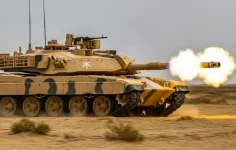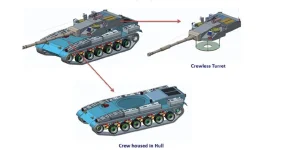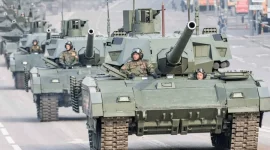- Views: 1K
- Replies: 1
The Indian Air Force's (IAF) Medium Transport Aircraft (MTA) program has outlined its major procurement initiative to acquire up to 80 new, medium transport aircraft to replace its ageing fleets of Antonov An-32 and Ilyushin Il-76 planes.
The program also aims for indigenous manufacturing in line with the "Make in India" initiative with the selected OEM to establish a local manufacturing facility in India in collaboration with a local industry player..
Key Details
Objective: The program intends to replace the IAF’s existing & legacy An-32s and some Il-76s, which are slated to be phased out starting from the early 2030s.Capacity: The IAF has specified an overall cargo carrying capacity ranging from 18 to 30 tonnes for the new aircraft. A key requirement is the ability to be able to airlift the latest 25-ton Zorawar Light Tank inside the aircraft’s cargo bay.
Status: The program is currently in the initial evaluation phase following a Request for Information (RFI) issued in early 2023. The Defense Ministry is expected to issue a formal tender in early 2026 after according its "Acceptance of Necessity" (AoN).
Procurement Model: The aircraft are to be manufactured in India through a partnership between a global original equipment manufacturer (OEM) and an Indian company, involving significant technology transfer.
Key Contenders and their Local Partnerships
Several global aerospace companies have responded to the RFI and formed alliances with Indian partners to bid for the program:- Embraer C-390 Millennium:Embraer Defense & Security has formed a strategic alliance with the Mahindra Group to offer the C-390 and potentially establish an assembly line in India. The C-390 has a payload capacity of 26 tonnes.
- Lockheed Martin C-130J Super Hercules:Lockheed Martin is pitching its C-130J-30 variant and has expanded its existing partnership with Tata Advanced Systems Limited (TASL) for potential local production and maintenance, repair, and overhaul (MRO) facilities. The C-130J has a 20-tonne payload capacity, which may be a limiting factor for the Zorawar tank requirement.
- Airbus A400M Atlas:Airbus has expressed interest and is pitching the A400M, leveraging its existing tie-up with TASL for the C-295 program. The A400M has a 37-tonne capacity, placing it slightly above the specified range, but it offers high strategic airlift capabilities.
- Ilyushin Il-276 (Potential):Russia is also looking to re-enter the contest, proposing the Il-276 in alliance with Hindustan Aeronautics Limited (HAL), after the original joint developmental project was scrapped in 2016. The program is a key part of the IAF’s comprehensive modernization of its transport fleet, which also includes the ongoing induction of C-295 aircraft to replace the older Avro aircraft.
The Middleweight Contenders Competing for a Shot at the Title
C-130J Super Hercules
The C-130J Super Hercules is a four-engine turboprop military transport aircraft and the latest version of the enduring C-130 Hercules family, currently the only model in production. Manufactured by Lockheed Martin, it features significant technological enhancements over its predecessors, including new engines, a modern flight deck, and a reduced crew requirement.Key Features and Specifications
- Engines:Powered by 4 Rolls-Royce AE 2100D3 turboprop engines with six-bladed, all-composite propellers, which provide improved performance and fuel efficiency.
- Flight Deck:Features an advanced, two-pilot flight station with fully integrated digital avionics, color multifunctional liquid crystal displays, and head-up displays, which reduces crew workload and increases situational awareness.
- Performance:The C-130J climbs faster and higher, flies farther at a higher cruise speed, and takes off and lands in a shorter distance than previous models.
- Cargo:It has an aft-loading ramp and door system and can be rapidly reconfigured for various cargo types, personnel, or aeromedical evacuation. The standard J-model can carry six pallets, while the stretched C-130J-30 variant (an extra 15 feet in length) can hold eight pallets or up to 128 combat troops.
- Austere Operations:Its rugged design and high-flotation landing gear allow it to operate from short, rough, and unprepared dirt strips.
Operational Capabilities and Variants
The C-130J's versatile platform enables it to perform a wide range of missions beyond standard airlift:- Aerial Refueling: The KC-130J variant serves as an aerial refueling tanker for helicopters and tilt-rotor aircraft.
- Special Operations: The MC-130J Commando II is designed for special operations missions, including clandestine infiltration, resupply, and exfiltration.
- Search and Rescue/Personnel Recovery: The HC-130J variant is used for long-range search and rescue and combat search and rescue missions.
- Air Support/Attack: The AC-130J Ghostrider is a heavily armed gunship variant for ground attack and armed reconnaissance.
- Weather Reconnaissance: The WC-130J variant (nicknamed "Hurricane Hunter") is used by the U.S. Air Force Reserve Command for weather monitoring.
- Fire Fighting System (MAFFS) can be loaded onto a C-130J to act as an air tanker for wildfires.
- Civilian Use: The LM-100J is a civil-certified multi-purpose air freighter version.
A400M Atlas
The Airbus A400M Atlas is a versatile, four-engine turboprop European military transport aircraft designed for both tactical airlift and strategic "oversize" lift capabilities for a group of European nations as a collaborative defense project. It was developed by Airbus Defence and Space to replace aging fleets of existing aircraft, like the Lockheed C-130 Hercules and the Transall C-160.Key Features and Capabilities
- Payload and Cargo Capacity: The A400M can carry a maximum payload of up to 37 tons, including large and heavy military equipment such as armored vehicles, a dump truck and excavator, or a Puma or Cougar helicopter. Its large cargo hold is 17.71 m (58.1 ft) long, 4 m (13.12 ft) wide, and 3.85 m (12.6 ft) high.
- Operational Flexibility: The aircraft is designed to operate from both conventional civilian/military runways and short, unprepared/improvised landing strips (e.g., gravel, sand, dirt), giving it excellent tactical reach.
- Multi-Role Capability: Beyond cargo and troop transport (up to 116 fully equipped paratroopers), the A400M can be reconfigured for other roles, including:
- Aerial Refueling: It can act as a tanker to refuel other aircraft, including helicopters, using hose-and-drogue refuelling pods or a center-line unit.
- Medical Evacuation (Medevac): It can be converted into a flying intensive care unit, accommodating up to 66 NATO-standard stretchers and a medical team.
- Humanitarian Aid: It has been extensively used in disaster relief operations, delivering food, water, and essential supplies.
- Advanced Technology: It features a full glass cockpit with head-up displays (HUD), fly-by-wire flight control systems, and defensive aids systems for enhanced survivability in hostile environments.
- Powerful Engines: It is powered by four Europrop TP400-D6 turboprop engines, the most powerful turboprop engines in the West to enter operational use, enabling a maximum speed of around 780 km/h (Mach 0.68). A unique feature is the "down between engines" (DBE) counter-rotating propellers on each wing, which reduce torque and increase lift.
Primary operators include: Belgium (part of a bi-national fleet with Luxembourg), France, Germany, Luxembourg, Malaysia, Spain, Turkey, United Kingdom (Royal Air Force), Kazakhstan has also signed an agreement to purchase two A400Ms.
Operational History: The A400M's maiden flight was on December 11, 2009, from Seville, Spain, and it entered service with the French Air Force in August 2013. It has since been deployed in various operations, including combat missions in Afghanistan, refueling operations against ISIL, and numerous humanitarian aid and evacuation efforts worldwide.
C-390 Millennium
The Embraer C-390 Millennium is one of the latest medium-sized, twin-engine jet-powered military transport aircraft developed and manufactured by Embraer in Brazil. It is a versatile aircraft designed for multiple missions, including cargo & troop transport, aerial refueling, medical evacuation, search and rescue, and aerial firefighting.Key Features and Capabilities
- Payload and Cargo:It can carry a maximum payload of up to 26 tonnes (57,000 lbs), exceeding the capacity of similar turboprop aircraft like the C-130J Super Hercules. Its large cargo hold can transport various items, including armored vehicles, helicopters, up to 80 troops, or 66 paratroopers.
- Speed and Range:Powered by two IAE V2500-E5 turbofan engines, the C-390 has a maximum cruise speed of 470 knots (870 km/h). It has a ferry range of over 3,300 nautical miles (6,100 km).
- Operational Flexibility:The aircraft is designed to operate from various runway conditions and in challenging environments. Its cargo system allows for rapid reconfiguration for different mission profiles.
- Advanced Systems:It incorporates modern features, like a fly-by-wire system, advanced avionics, and night vision capabilities.
- Aerial Refueling (KC-390 Variant):The KC-390 variant can perform aerial refueling using a probe-and-drogue system and can also be refueled in flight.
Stacking Up the Mediumweights
The C-130J Super Hercules is the most proven platform for tactical airlift and treated almost as an undisputed gold standard for tactical airlift globally for a range of mission profiles. Further, the IAF is already an operator of the C-130J platform with training, logistics & MRO capabilities already duly in-place providing significant operational & fleet synergies as well as advantages.However, its payload capacity maxes out at 20 tons and it, thus, can’t carry the under development 25 ton Zorawar light tank, which is a key imperative for India. Also, Trump’s recent & ongoing anti-India strategic posture as well as stance and hostile foreign policy overtures marked by trade tariffs and threat of sanctions over Russian oils and defense dealings are likely to be an impediment & dampener to India’s potential choice for an American military platform going forward amid the latest geopolitical realities.
The A400M Atlas and its capabilities lie somewhere in between a tactical & strategic airlifter with a maximum payload capacity of around 37 tons and almost matching the IL-76’s capabilities of airlifting 40 tonnes in the IAF’s inventory. It can, thus, be used for both tactical as well as strategic airlift missions, as desired, thereby, providing a lot of flexibility to the IAF. However, being capable of both tactical & strategic airlift missions, the Atlas has a much higher per unit & sustainment costs than other contenders which are purely tactical airlifters. The unit cost of the A400M ranges from $160 to $187 million, depending on configuration, unlike the C-130J and the C-390M, both of which are available for around $80+ million.
The C-390 Millennium is a jet-powered tactical airlifter, unlike any other contender, thereby giving it an advantage. Also, powered by a pair of proven, reliable & highly efficient V2500 jet engines, which have been used extensively in commercial aviation since the 1980s, the C-390 has easy access to a vast & extensive global commercial MRO footprint for the V2500 engine, thereby, making it easy & cost effective to maintain.
Also, the jet-powered C-390 Millennium flies faster than turboprop planes and is, therefore, given & allocated a higher cruise altitude by the air traffic controls globally, thereby, giving it a clear & distinct advantage over the conventional, turboprop-powered airlifters. Embraer is also offering India a favorable deal, including a potential barter, in which, Embraer will buy India’s homegrown Teas fighter jets, in lieu, of the C-390 Millennium airplanes.
The C-390 Millennium, therefore, leads this 3-horse derby with a fair and credible shot at the title. It is my pick of the lot as well and should be able to emerge triumphant out of this race unless it’s hit by an unforeseen, severe turbulence or a lightning strike or Lockheed pulls off a real miracle here…



